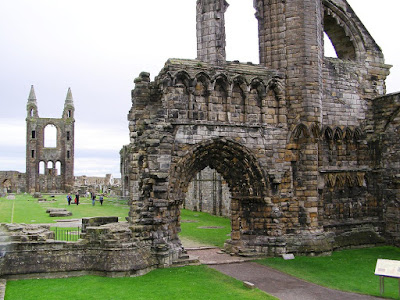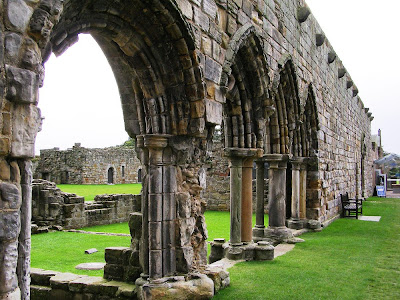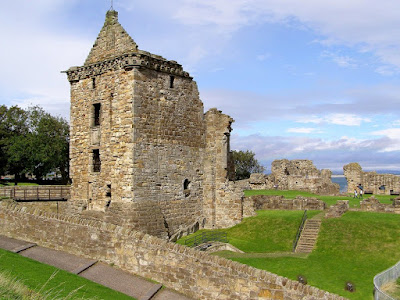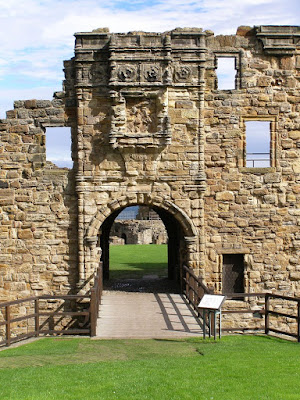We started with a walk around the ancient town of St. Andrews. Both Malcolm and I had previously associated St. Andrews with golf and very little else. How wrong we were. To start with, there were the ruins of the Cathedral of St. Andrew.
Founded in 1158, it took over one hundred years to complete. The west end blew down in a storm and had to be rebuilt between 1272 and 1279. It was dedicated in 1318, in a ceremony before King Robert I . When finished it had a central tower and six turrets. Of these, two at the east and one of the two at the western extremity remain, rising to 100ft.
Fire partly destroyed the building in 1378 and the restoration was completed in 1440. It was stripped of its altars and images in 1559.
A short distance from the cathedral are the remains of St. Andrews Castle. The Castle was the official residence of Scotland’s leading bishop throughout the Middle Ages. Its scale demonstrates the power and wealth of the bishops, and it was the setting for many important events in the course of Scottish history.
Bishop Roger began the new castle as his official residence around 1200. During the Wars of Independence with England, the castle suffered significant damage, and had to be substantially rebuilt by Bishop Walter Trail in about 1400.
Increasing religious tensions in the early 16th century led to further building works. Archbishop James Beaton strengthened the castle's defences , building new gun towers. His nephew, Cardinal David Beaton, opposed the move to closer political ties with Henry VIII’s Protestant England. Beaton had the Protestant preacher, George Wishart, burned in front of the castle. This resulted in his own murder, and the occupation of his castle by Protestants.
Founded in 1158, it took over one hundred years to complete. The west end blew down in a storm and had to be rebuilt between 1272 and 1279. It was dedicated in 1318, in a ceremony before King Robert I . When finished it had a central tower and six turrets. Of these, two at the east and one of the two at the western extremity remain, rising to 100ft.
Fire partly destroyed the building in 1378 and the restoration was completed in 1440. It was stripped of its altars and images in 1559.
A short distance from the cathedral are the remains of St. Andrews Castle. The Castle was the official residence of Scotland’s leading bishop throughout the Middle Ages. Its scale demonstrates the power and wealth of the bishops, and it was the setting for many important events in the course of Scottish history.
Bishop Roger began the new castle as his official residence around 1200. During the Wars of Independence with England, the castle suffered significant damage, and had to be substantially rebuilt by Bishop Walter Trail in about 1400.
Increasing religious tensions in the early 16th century led to further building works. Archbishop James Beaton strengthened the castle's defences , building new gun towers. His nephew, Cardinal David Beaton, opposed the move to closer political ties with Henry VIII’s Protestant England. Beaton had the Protestant preacher, George Wishart, burned in front of the castle. This resulted in his own murder, and the occupation of his castle by Protestants.





No comments:
Post a Comment